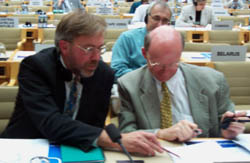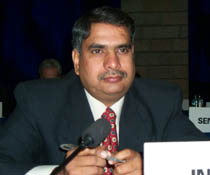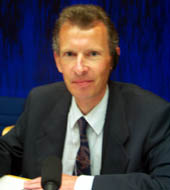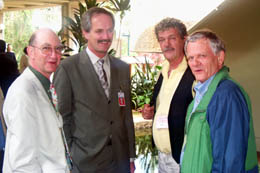 |
 David Pritchard spoke on behalf of BIRDLIFE INTERNATIONAL,
the International Association on Impact Assessment (IAIA) and
the Ramsar Convention Scientific and Technical Review Panel on
Environmental Impact Assessment. He said these institutions welcome
cooperative links with the CBD and the integration of biodiversity
concerns into EIA legislation. He added that a 12-point IAIA work
programme has made progress on this topic and IAIA has put together
a glossary of terms and a register of experts.
David Pritchard spoke on behalf of BIRDLIFE INTERNATIONAL,
the International Association on Impact Assessment (IAIA) and
the Ramsar Convention Scientific and Technical Review Panel on
Environmental Impact Assessment. He said these institutions welcome
cooperative links with the CBD and the integration of biodiversity
concerns into EIA legislation. He added that a 12-point IAIA work
programme has made progress on this topic and IAIA has put together
a glossary of terms and a register of experts.
|
|
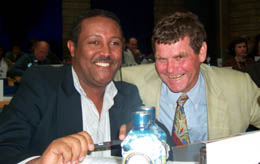 "Two
Microphones, One Voice" "Two
Microphones, One Voice" ETHIOPIA [left] opposed postponing discussion and supported
establishing a technical group for substantive evaluation of the
issues of biosafety, environmental liability and impact assessment.
ETHIOPIA [left] opposed postponing discussion and supported
establishing a technical group for substantive evaluation of the
issues of biosafety, environmental liability and impact assessment.
 The EUROPEAN COMMISSION agreed [right], stressing the
high priority of environmental liability and biosafety to Europe.
He further emphasized the need to launch a negotiating process to
develop coherence between CBD Article 14, the Basel Convention and
the Biosafety Protocol so as not to create separate liability regimes.
The EUROPEAN COMMISSION agreed [right], stressing the
high priority of environmental liability and biosafety to Europe.
He further emphasized the need to launch a negotiating process to
develop coherence between CBD Article 14, the Basel Convention and
the Biosafety Protocol so as not to create separate liability regimes.
|
 AUSTRALIA supported development of guidelines and case studies,
and preferred considering environmental liability and redress at
COP-7 or at a later date
AUSTRALIA supported development of guidelines and case studies,
and preferred considering environmental liability and redress at
COP-7 or at a later date |
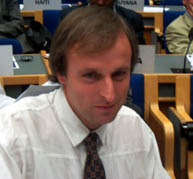 |
|
 CANADA expressed concerns over the feasibility of policy guidelines
for EIA. He said work should focus on interim arrangements for
biosafety and case studies. He opposed setting a particular date
or COP for tackling the environmental liability issue.
CANADA expressed concerns over the feasibility of policy guidelines
for EIA. He said work should focus on interim arrangements for
biosafety and case studies. He opposed setting a particular date
or COP for tackling the environmental liability issue.
|
|
| MINISTERIAL
ROUNDTABLE |
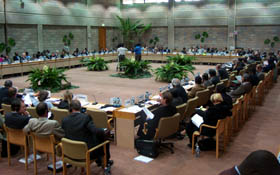 CBD COP-5 President Nyenze welcomed Ministers and opened the discussion
on capacity-building to facilitate implementation of the Cartagena
Protocol. Dr. Klaus Töpfer, UNEP Executive Director, remarked
that the best international framework is worthless unless it closes
the gap between the developed and developing countries. Simon
Barber, EuropaBio, identified the need for capacity-building to
provide research infrastructure, risk assessment evaluators, and
information on local and regional environments. Lim Li Lin, Third
World Network, suggested that developing countries conduct cost-benefit
analysis to determine the need for GMOs and that they should have
access to GMO detection facilities.
CBD COP-5 President Nyenze welcomed Ministers and opened the discussion
on capacity-building to facilitate implementation of the Cartagena
Protocol. Dr. Klaus Töpfer, UNEP Executive Director, remarked
that the best international framework is worthless unless it closes
the gap between the developed and developing countries. Simon
Barber, EuropaBio, identified the need for capacity-building to
provide research infrastructure, risk assessment evaluators, and
information on local and regional environments. Lim Li Lin, Third
World Network, suggested that developing countries conduct cost-benefit
analysis to determine the need for GMOs and that they should have
access to GMO detection facilities.
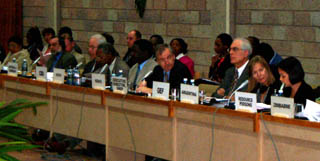 Developed
and developing countries underscored the need for improved technical
and scientific capacity and identified areas for capacity-building,
including: regulation; risk assessment; risk management; enforcement;
information sharing; institutional strengthening; and legislation
development. Several delegates also expressed support for the
UNEP/GEF enabling pilot project and requested more GEF funding. Developed
and developing countries underscored the need for improved technical
and scientific capacity and identified areas for capacity-building,
including: regulation; risk assessment; risk management; enforcement;
information sharing; institutional strengthening; and legislation
development. Several delegates also expressed support for the
UNEP/GEF enabling pilot project and requested more GEF funding.
MALAWI requested
training for awareness on safe use and handling of GMOs. NIGER
stressed combating desertification and poverty. TURKEY called
for national assessments to identify urgent needs. UGANDA requested
assistance in creating a biodiversity inventory. NIGERIA suggested
establishing a database on biodiversity financing. SRI LANKA suggested
a regional biosafety CHM. KIRIBATI advocated public awareness
campaigns. SWITZERLAND, URUGUAY and others supported regional
collaboration. SWITZERLAND called for improved collaboration among
ongoing capacity-building initiatives. NORWAY said biotechnology
must be developed with caution and in an ethical manner. AUSTRALIA
cautioned against using biotechnology for market protectionism.
The NETHERLANDS identified the need to find a balance between
protection of IPR and local farmers rights. FRANCE offered provision
of information and expert training.
|
|
|
Side event: Making the CBD
Work: A Delegate Roundtable on Improving CBD Effectiveness
|
|
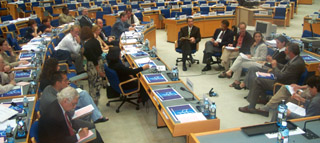 An
informal roundtable facilitated by George Green and organized by
Desiree McGraw, both of the delegation of Canada, on improving the
effectiveness of the CBD. Panelists included representatives from
Canada, Mexico, the UK, UNEP and the USA, while those in the audience
came from Africa, Europe and Latin America. An
informal roundtable facilitated by George Green and organized by
Desiree McGraw, both of the delegation of Canada, on improving the
effectiveness of the CBD. Panelists included representatives from
Canada, Mexico, the UK, UNEP and the USA, while those in the audience
came from Africa, Europe and Latin America.
Panelists likened
the CBD to: "the mother of conventions" for being comprehensive
and complex; being the "the ugly sister of the Cinderellas"
i.e. CITES and the Framework Convention on Climate Change since
it lacks the political backing and limelight in the public eye.
They also described the CBD to a convention that is "hard to love"
or an outright dysfunctional structural beast with a gigantic scope
where everything is equally important. Others noted that "everyone
plants their colonial interests and their red flags" on specific
issues such as taxonomy, ecotourism, marine parks. Nevertheless,
participants expressed optimism that the CBD could be strengthened.
The upcoming enactment of the Biosafety Protocol was seen as a window
of opportunity to strategically redirect the Convention's fragmented
work programme and procedures. Many felt it is time to clarify objectives
and develop flexible guidelines, national targets, and decisions
about trade and environment.
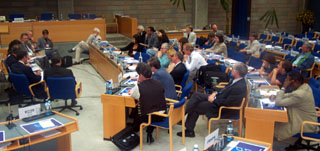 Participants
noted that the sectoralization and fragmentation of the CBD's agenda
was occurring in juxtaposition with shrinking budgets and diminishing
public profile. The CBD's memorandums of understanding with other
conventions remain "miserably" vague. The CBD has yet
to tackle its economic and trade-related linkages with institutions
such as WIPO and WTO. The CBD also has also failed to be responsive
to current biodiversity crises of the day such as major forest fires
or coral bleaching. Participants
noted that the sectoralization and fragmentation of the CBD's agenda
was occurring in juxtaposition with shrinking budgets and diminishing
public profile. The CBD's memorandums of understanding with other
conventions remain "miserably" vague. The CBD has yet
to tackle its economic and trade-related linkages with institutions
such as WIPO and WTO. The CBD also has also failed to be responsive
to current biodiversity crises of the day such as major forest fires
or coral bleaching.
Recommendations
for making the CBD work better included interlinking and streamlining
environmental conventions and national reporting. Participants suggested
prioritizing the issue of trade and biodiversity rules, scientific
assessments such as the Millennium Ecosystem Assessment, and implementation
agreements at regional and national levels. Speakers recommended
that the CBD develop a strategic plan to revise objectives, set
performance goals and develop ways to measure compliance. Some encouraged
the promotion of a global list of, or national targets for, designating
areas for conservation and sustainable use. Others felt that because
biodiversity is not evenly distributed across the globe and the
CBD has increasingly moved into the economic arena, such an approach
may not be feasible.
For more information,
contact Desiree McGraw: [dezm@msn.com]
|
|
|
Side event: Book Launches
|
|
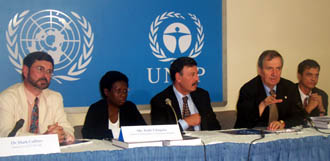 UNEP
hosted a side-event with Intermediate
Technologies Publication Group (ITPG), and the World
Conservation and Monitoring Center (WCMC) to launch two books:
Global Biodiversity: Earth's Living Resources in the 21st Century
and Cultural and Spiritual Values of Biodiversity. UNEP
hosted a side-event with Intermediate
Technologies Publication Group (ITPG), and the World
Conservation and Monitoring Center (WCMC) to launch two books:
Global Biodiversity: Earth's Living Resources in the 21st Century
and Cultural and Spiritual Values of Biodiversity.
Speakers included
Klaus Topfer, UNEP Executive Secretary; Mark Chakrabarty, UNEP Task
Management; Ruth Liloqula, Soloman Islands delegate and contributor
to the volume on cultural values; and Mark Collins, Director of
UNEP-WCMC.
Cultural
and Spiritual Values of Biodiversity: A Complementary Contribution
to the Global Biodiversity Assessment, 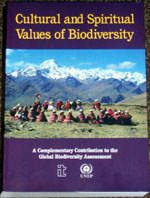 edited
by Darrell A. Posey, was launched by UNEP and Intermediate Technologies.
Weaving together philosophical, historical, legal, scientific and
personal viewpoints, this book gives a rich sample of the vast web
which makes up our cultural, spiritual and social diversity. The
volume highlights the key role of cultural and spiritual values
in the appreciation and preservation of all life, arguing that these
values give us a true reflection of worth. The volume also directly
addresses two CBD Articles: Art.8(j) on the respect, preservation
and maintenance of the knowledge, innovations and practices of indigenous
and local communities embodying traditional lifestyles relevant
for in situ conservation and sustainable use of biological
diversity; and Art.15 on access to genetic resources and national
authority. Chapters cover topics such as the complex issue of indigenous
people, holistic health practices where environment and diet are
integrated into indigenous and medical health systems, and the importance
of effective intellectual property rights and territorial and land
rights to enhance and maintain local control. edited
by Darrell A. Posey, was launched by UNEP and Intermediate Technologies.
Weaving together philosophical, historical, legal, scientific and
personal viewpoints, this book gives a rich sample of the vast web
which makes up our cultural, spiritual and social diversity. The
volume highlights the key role of cultural and spiritual values
in the appreciation and preservation of all life, arguing that these
values give us a true reflection of worth. The volume also directly
addresses two CBD Articles: Art.8(j) on the respect, preservation
and maintenance of the knowledge, innovations and practices of indigenous
and local communities embodying traditional lifestyles relevant
for in situ conservation and sustainable use of biological
diversity; and Art.15 on access to genetic resources and national
authority. Chapters cover topics such as the complex issue of indigenous
people, holistic health practices where environment and diet are
integrated into indigenous and medical health systems, and the importance
of effective intellectual property rights and territorial and land
rights to enhance and maintain local control. 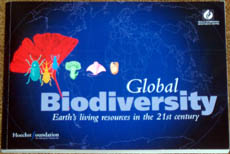 For
a copy, contact Intermediate Technology Publications Group by e-mail
at [orders@itpubs.org.uk]
or visit their web site at [http://www.itpubs.org.uk/].
The book is also available online in PDF format at
[http://www.unep.org/Biodiversity/unep.pdf]
(25 MB). For
a copy, contact Intermediate Technology Publications Group by e-mail
at [orders@itpubs.org.uk]
or visit their web site at [http://www.itpubs.org.uk/].
The book is also available online in PDF format at
[http://www.unep.org/Biodiversity/unep.pdf]
(25 MB).
Global Biodiversity:
Earth's Living Resources, by Brian Groombridge and Martin Jenkins,
was launched by the WCMC and UNEP as a follow-up to Global Biodiversity:
Status of the Earth's Living Resources. This definitive reference
publication for environmentalists, students and businesses uses
the most up to the minute critical data available to provide a comprehensive
outline of the broad ecological relationships between humans and
the rest of the biosphere. It thus summarizes information bearing
on the health of the living Earth at the end of the 20th century.
For a copy, contact [info@wcmc.org.uk]
or visit [http://www.wcmc.org.uk/]
(specific information available at http://www.wcmc.org.uk/resources/publications/otherpubs.htm)
|
|
|
Side event: Root Causes
of Biodiversity Loss
|
|
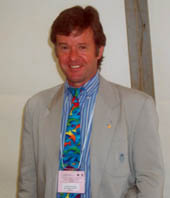 The
World Wide Fund for Nature (WWF)
hosted a workshop on the root causes of biodiversity loss. Gordon
Sheppard, WWF [left], moderated the discussion. Johanna Mang,
WWF [right], gave an overview of proximate and underlying
causes of biodiversity loss. She presented an analytical framework
used to identify and address the proximate causes The
World Wide Fund for Nature (WWF)
hosted a workshop on the root causes of biodiversity loss. Gordon
Sheppard, WWF [left], moderated the discussion. Johanna Mang,
WWF [right], gave an overview of proximate and underlying
causes of biodiversity loss. She presented an analytical framework
used to identify and address the proximate causes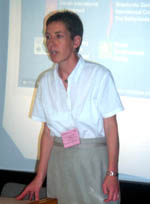 of biodiversity loss (e.g. habitat loss, pollution, climate change
and over-harvesting) driven by underlying causes including poverty,
macroeconomic policies, markets, public policy, demographic changes,
social change and development. She noted that WWF has undertaken
a number of case studies using this approach in Brazil, China, the
Danube River Basin, India, Mexico, Pakistan, Philippines, Tanzania
and Vietnam.
of biodiversity loss (e.g. habitat loss, pollution, climate change
and over-harvesting) driven by underlying causes including poverty,
macroeconomic policies, markets, public policy, demographic changes,
social change and development. She noted that WWF has undertaken
a number of case studies using this approach in Brazil, China, the
Danube River Basin, India, Mexico, Pakistan, Philippines, Tanzania
and Vietnam.
She highlighted
the case of Cameroon and biodiversity loss resulting from bush-meat
and wildlife trade. She said root causes encouraging such behavior
differ according to the geographic level. At the local level, root
causes include consumption, cultural change, land tenure and economic
opportunities. At the national level, causes include the national
development model, natural resource extraction, infrastructure and
institutional/political considerations. Finally, at the international
level, Cameroon's IMF/World Bank Structural Adjustment Program (SAP)
and external market demand have perpetuated the situation. Recommendations
for this specific case involved national environmental controls,
work on SAPs, biodiversity valuation and CITES reform.
The ensuing
discussion focused on the use and funding of WWF's analytical tools
under the CBD. Potential benefits could include more specific and
contextual understandings of why biodiversity is being lost locally
and nationally; biodiversity-friendly sectoral reforms; capacity-building
and awareness raising for national biodiversity strategies and action
plans; consensus- building among stakeholders; and identification
of feasible and early interventions to put biodiversity on the national
agenda.
The report
on which this presentation was based, Socioeconomic Root Causes
of Biodiversity Loss: Applied Case Study Summaries, is available
online at [http://www.panda.org/resources/publications/sustainability/mpo/library/abstracts/abstract-applied_case.htm]
|
|
|
Miscellaneous
|
|
|
Discussing
convention synergies, from left to right: Peter Bridgewater, UNESCO
MAB Programme; Willem Wijnstekers, CITES Secretary-General; Hank Jenkens,
IUCN Sustainable Use Initiative; and Veit Koester, Head of Danish
delegation and former Chair of the Biosafety Working Group. |
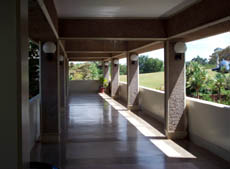 IN
THE BREEZEWAYS IN
THE BREEZEWAYS
With tentative agreement on a decision for the operations of the
Convention, discussions have been focusing on the CBD's effectiveness.
Some delegates noted a fragmentation of the CBD's umbrella approach
into sectoral activities championed by various Party interest groups,
which has hampered issue prioritization, agenda streamlining and
GEF guidance. Others noted the CBD's relative youth, stressing the
need to establish the basic work programmes first and then to build
ecosystem integration into their further elaboration. Right:
at the UN compound at Gigiri, buildings are not separated
by closed corridors, instead they are linked by open breezeways.
|
|


